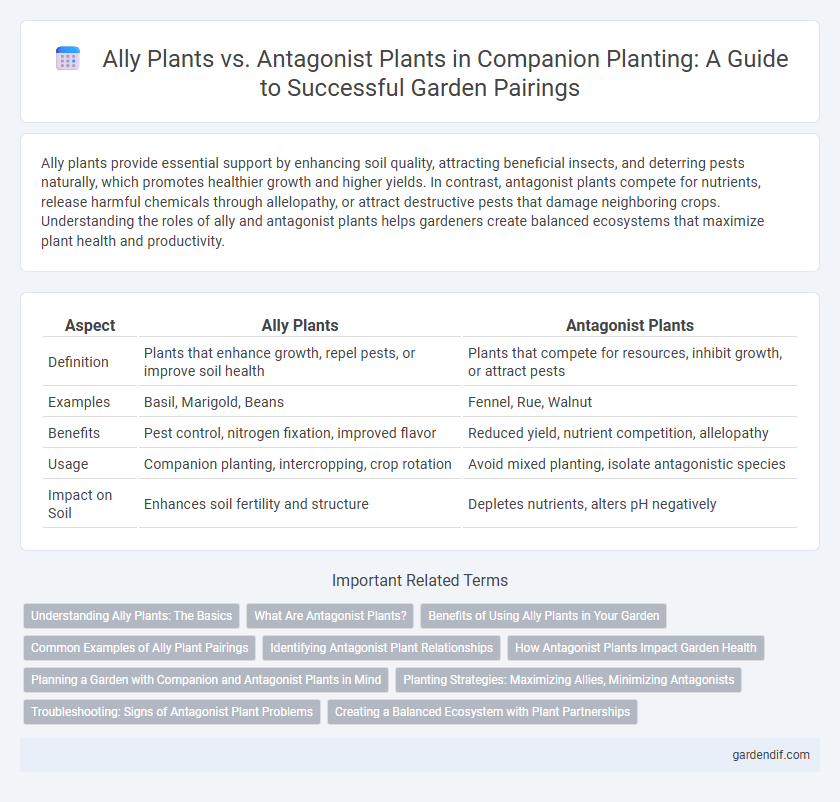
Ally plants vs antagonist plants Illustration
Ally plants provide essential support by enhancing soil quality, attracting beneficial insects, and deterring pests naturally, which promotes healthier growth and higher yields. In contrast, antagonist plants compete for nutrients, release harmful chemicals through allelopathy, or attract destructive pests that damage neighboring crops. Understanding the roles of ally and antagonist plants helps gardeners create balanced ecosystems that maximize plant health and productivity.
Table of Comparison
| Aspect | Ally Plants | Antagonist Plants |
|---|---|---|
| Definition | Plants that enhance growth, repel pests, or improve soil health | Plants that compete for resources, inhibit growth, or attract pests |
| Examples | Basil, Marigold, Beans | Fennel, Rue, Walnut |
| Benefits | Pest control, nitrogen fixation, improved flavor | Reduced yield, nutrient competition, allelopathy |
| Usage | Companion planting, intercropping, crop rotation | Avoid mixed planting, isolate antagonistic species |
| Impact on Soil | Enhances soil fertility and structure | Depletes nutrients, alters pH negatively |
Understanding Ally Plants: The Basics
Ally plants enhance garden health by attracting beneficial insects that prey on pests, improving soil quality through nitrogen fixation, and providing natural pest repellents. These plants create symbiotic relationships that boost growth and resilience of nearby crops. Selecting the right ally plants involves understanding their specific functions and compatibility with target plants to maximize garden productivity.
What Are Antagonist Plants?
Antagonist plants are species that inhibit the growth or survival of neighboring plants through natural chemical secretions, often referred to as allelopathy. These plants release toxins into the soil or air, creating an unfavorable environment for competitors and pests, thereby protecting companion plants from diseases and infestations. Understanding antagonist plants such as black walnut (Juglans nigra) or eucalyptus is crucial in companion planting to avoid planting conflicts and enhance garden health.
Benefits of Using Ally Plants in Your Garden
Ally plants enhance garden health by improving soil quality, attracting beneficial insects, and repelling harmful pests naturally. They create a balanced ecosystem that reduces the need for chemical pesticides and fertilizers, promoting sustainable gardening practices. Integrating ally plants like basil with tomatoes or marigolds with beans boosts crop yield and plant resilience.
Common Examples of Ally Plant Pairings
Ally plants like basil and tomatoes create beneficial relationships by repelling pests and enhancing growth, making them prime examples of companion planting. Marigolds paired with cucumbers serve to deter nematodes and attract pollinators, while beans combined with corn improve nitrogen availability in the soil. These synergistic pairings optimize garden health and increase crop yields through natural pest resistance and nutrient sharing.
Identifying Antagonist Plant Relationships
Ally plants enhance growth by improving nutrient absorption and deterring pests, while antagonist plants compete for resources or release harmful chemicals that inhibit growth. Identifying antagonist plant relationships involves recognizing species known for allelopathy or aggressive root systems that hinder neighboring plants. Gardeners use companion planting charts and observe plant health indicators to avoid placing antagonistic pairs close together, ensuring optimal plant development.
How Antagonist Plants Impact Garden Health
Antagonist plants negatively impact garden health by competing aggressively for nutrients, water, and sunlight, which stunts the growth of beneficiary companion plants. They can also harbor pests and diseases, increasing the risk of infestations and infections that compromise overall plant vitality. Managing antagonist plants is crucial to maintaining a balanced ecosystem and promoting optimal growth conditions for ally plants.
Planning a Garden with Companion and Antagonist Plants in Mind
Planning a garden with companion and antagonist plants in mind enhances plant health and yield by leveraging natural relationships. Companion plants like basil and tomatoes improve growth and deter pests, while antagonist plants such as onions planted near peas can inhibit development. Strategically arranging these plants based on their interactions optimizes space, boosts productivity, and reduces the need for chemical interventions.
Planting Strategies: Maximizing Allies, Minimizing Antagonists
Planting strategies that maximize ally plants improve garden health by enhancing nutrient uptake and pest resistance through complementary root structures and natural repellent properties. Minimizing antagonist plants involves avoiding species that compete for resources or attract harmful pests which can inhibit growth and reduce yields. Strategic spatial arrangement and crop rotation tailored to specific plant interactions ensure optimal growth conditions while fostering biodiversity and soil vitality.
Troubleshooting: Signs of Antagonist Plant Problems
Signs of antagonist plant problems include stunted growth, yellowing leaves, and poor flowering in ally plants. Root competition and allelopathy often cause nutrient deficiencies and wilting symptoms. Monitoring these indicators early helps troubleshoot and manage incompatible plant pairings effectively.
Creating a Balanced Ecosystem with Plant Partnerships
Ally plants enhance growth and pest resistance by providing complementary nutrients, attracting beneficial insects, or repelling harmful pests, fostering a balanced ecosystem. Antagonist plants, in contrast, compete for resources or release allelopathic chemicals that inhibit neighboring plant development, disrupting natural plant harmony. Strategic selection of companion plants maximizes beneficial interactions while minimizing antagonistic effects, promoting sustainable garden health and biodiversity.
Ally plants vs antagonist plants Infographic

 gardendif.com
gardendif.com